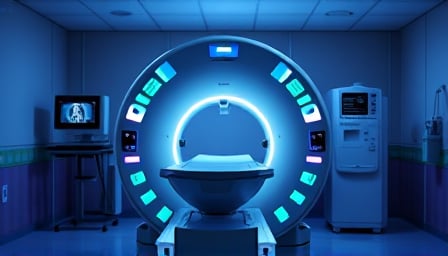Siemens Healthineers AG: Strategic Moves Amid a Volatile Macro‑Environment
Siemens Healthineers AG (SHG) continues to reinforce its position as a leader in medical technology through a combination of targeted partnerships, talent acquisitions, and a disciplined focus on core product categories. The company’s stock has exhibited relative stability, yet market sentiment remains tempered by broader macroeconomic uncertainties, notably the Federal Reserve’s stance on interest‑rate policy.
Market Context and Investor Sentiment
European equity markets closed mixed on Thursday, with SHG’s share price showing modest volatility. Investors appear cautious, reflecting uncertainty over potential Federal Reserve interest‑rate cuts and concerns about President Jerome Powell’s comments on near‑term trend following. These macro‑factors have a spill‑over effect on capital‑intensive sectors such as medical devices and diagnostics, where the cost of borrowing and investment decisions are closely tied to the broader economic outlook.
Despite the macro‑risk, Siemens Healthineers has managed to keep its market capitalization relatively stable. The company’s earnings fundamentals—driven by a diversified portfolio across imaging, laboratory diagnostics, and point‑of‑care solutions—continue to support a resilient valuation profile.
Strategic Partnerships and Talent Acquisition
Collaboration with Interventional Systems
In a move that underscores the firm’s commitment to innovation, Siemens Healthineers has entered a strategic partnership with Interventional Systems to develop surgical robotics solutions. This collaboration is designed to integrate advanced robotic platforms into the company’s existing imaging and interventional workflow ecosystem. By leveraging Interventional Systems’ expertise in precision robotics, Siemens Healthineers aims to:
- Enhance surgical outcomes through improved dexterity and real‑time imaging guidance.
- Differentiate its product portfolio in a crowded surgical robotics market, where competitors such as Intuitive Surgical and Medtronic are investing heavily.
- Accelerate time‑to‑market for hybrid operating room solutions that combine imaging, robotics, and workflow optimization.
The partnership is expected to strengthen Siemens Healthineers’ competitive positioning in the growing minimally invasive surgery segment, which is projected to grow at a CAGR of 7–9% over the next five years.
Appointment of a Former Executive as Chief Medical Officer at Integra
The appointment of a former Siemens Healthineers executive to the role of Chief Medical Officer (CMO) at Integra introduces a new dimension to the company’s collaborative strategy. The CMO’s prior experience with Siemens Healthineers’ diagnostics and imaging divisions could facilitate knowledge transfer and joint development initiatives. Potential synergies include:
- Shared research and development (R&D) pipelines for laboratory diagnostics and imaging technologies.
- Co‑marketing agreements that leverage Integra’s market reach in specific geographies where Siemens Healthineers seeks expansion.
- Joint regulatory pathways that could expedite approvals for new diagnostic assays or imaging modalities.
Such cross‑company talent flows illustrate how Siemens Healthineers is positioning itself to benefit from human capital mobility, a critical factor in an industry where expertise can be a decisive competitive advantage.
Core Business Focus and Market Dynamics
Siemens Healthineers remains anchored in three primary segments: medical imaging, laboratory diagnostics, and point‑of‑care testing. These areas are integral to its strategy for the In‑Vitro Diagnostics (IVD) Quality Control (QC) market, which is projected to grow as regulatory bodies increasingly demand higher standards for diagnostic accuracy.
Challenges Facing the IVD QC Market
While the IVD QC market offers robust growth prospects, it is beset by several structural challenges:
| Challenge | Impact |
|---|---|
| High System Costs | Reduces margin pressure for smaller laboratories and limits adoption in emerging markets. |
| Skilled‑Professional Shortage | Complicates deployment of sophisticated diagnostic platforms and may delay product roll‑outs. |
| Complex Regulatory Frameworks | Lengthens product approval timelines and increases compliance costs. |
Siemens Healthineers addresses these challenges through a combination of cost‑efficiency initiatives, workforce development programs, and strategic alliances that help navigate regulatory complexities.
Competitive Positioning
In the face of intense competition from both established medical device manufacturers and agile biotech startups, Siemens Healthineers differentiates itself through:
- Integrated Solutions: Seamless interoperability between imaging, diagnostic, and informatics platforms.
- Scale and Reach: A global footprint that allows for rapid deployment and post‑sales support.
- Innovation Pipeline: A strong R&D investment that keeps the company at the forefront of emerging technologies such as AI‑driven imaging and digital pathology.
Cross‑Industry Connections and Broader Economic Trends
Siemens Healthineers’ activities exemplify a broader trend toward convergence between technology sectors:
- Robotics and Imaging: The surgical robotics partnership illustrates how precision robotics are increasingly integrated with imaging to enable minimally invasive procedures.
- Data Analytics and Diagnostics: The company’s focus on digital pathology and AI‑enhanced diagnostics mirrors similar moves in the fintech and automotive sectors, where data analytics drives operational efficiency.
- Regulatory Harmonization: The challenges in the IVD QC market parallel those faced by aerospace and automotive manufacturers, where global regulatory alignment is critical for market entry.
These cross‑industry parallels highlight how foundational principles—such as technological integration, data‑driven decision making, and regulatory agility—transcend specific sectors. For Siemens Healthineers, success hinges on maintaining a disciplined approach to innovation while adapting to both macroeconomic fluctuations and evolving industry dynamics.
Conclusion
Siemens Healthineers AG demonstrates a balanced strategy that blends stable financial performance with aggressive investment in technology partnerships and talent acquisition. While market uncertainty—particularly regarding U.S. monetary policy—continues to influence investor sentiment, the company’s core strengths in imaging, diagnostics, and robotics position it to capitalize on growth opportunities in the medical technology landscape. Its proactive approach to navigating cost, skill, and regulatory challenges further solidifies its standing as a major player poised for sustained long‑term success.
